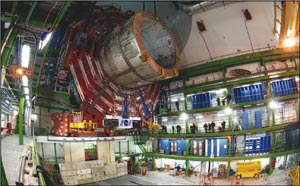At 6.00 a.m. on 28 February the heaviest section of the Compact Muon Solenoid (CMS) detector began its momentous journey into the experiment’s cavern, 100 m below ground. Using a huge gantry crane, custom-built by the Vorspann System Losinger Group, the pre-assembled central piece, weighing 1920 tonnes – or as much as five jumbo jets – was gently lowered into place, descending at a rate of about 10 m an hour. It finally touched down smoothly at 6.00 p.m., under the eyes and cameras of assembled press, hundreds of CMS collaboration sightseers and TV viewers around the world.

The giant element, 16 m tall, 17 m wide and 13 m long, consisted of the complete superconducting solenoid, together with the central section of the magnet return yoke. Its descent was a challenging feat of engineering, as there was only 20 cm leeway between the detector and the walls of the shaft. To make the journey, the piece was suspended by four massive cables, each with 55 strands and attached to a step-by-step hydraulic jacking system. Sophisticated monitoring and control ensured that it did not sway or tilt.

The CMS collaboration broke with tradition by starting assembly of the detector before completion of the underground cavern, taking advantage of a spacious surface assembly hall to pre-assemble and pre-test the solenoid magnet and the various detectors. There are 15 pieces altogether, and the descent of the central section marks the halfway point in the lowering process, with the last piece scheduled to go underground in the summer.





